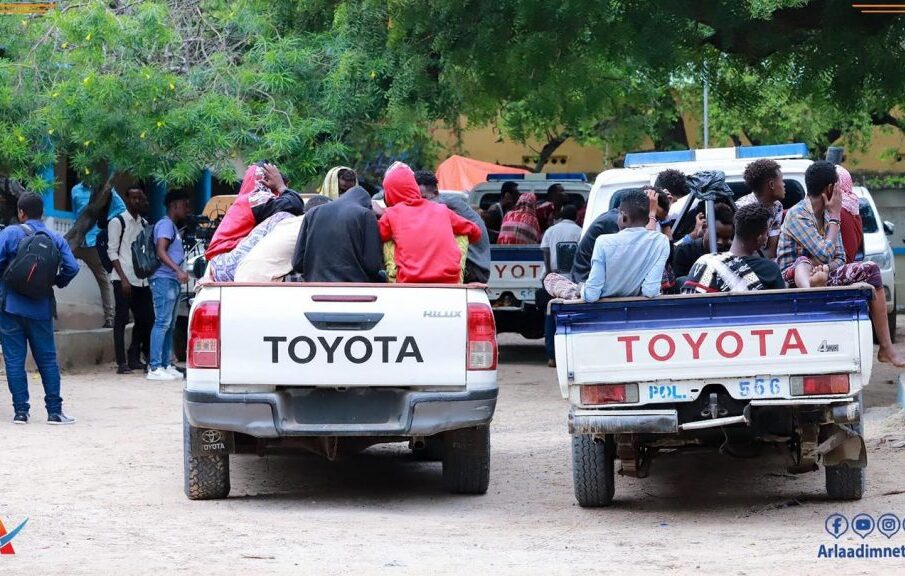‘Ciyaal Weero’: The Youth Gangs Terrorizing Mogadishu Residents

Suspected members of Ciyaal Weero rounded up by the police in Mogadishu in July 2022. Source: Arlaadi Media
In recent months, Mogadishu, the capital city of Somalia, has witnessed a surge in crimes committed by youth gangs known as Ciyaal Weero.
Until recently, the term Ciyaal Weero, derived from the Somali word “Ciyaal” meaning children, and the Italian word “guerra” meaning war, was used in Mogadishu to describe children between 8 – 14 years old who engage in neighborhood group fights using pebbles.
Very popular in the 1990s, the fights often took place on Thursdays and Fridays when Somalis observe the weekend. These fights were so common that it was rare to find a Mogadishu millennial who has not taken part in them, myself included.
The Ciyaal Weero of today, however, are a group of youth gangs who attack people, especially at night to rob them and sometimes to only torture them.
According to a recent governance brief by the Mogadishu-based Somali Public Agenda (SPA), the Ciyaal Weero surfaced in late 2021 and are made up of young men whose estimated average age is 23 years old.
Armed with small firearms, knives, sticks and machetes, the youth gangs have a profound presence in Mogadishu’s peripheral districts such as Kaaraan, Yaaqshid, Wadajir, Deyniile and Dharkenley.
‘Stab him’
Earlier this month, a Mogadishu-based journalist, Liban Abdi Warsame, detailed on his Facebook page an ordeal he experienced on the hands of Ciyaal Weero the night before.
“It was about 9.00 pm and I was walking down one of the streets of Wadajir district and suddenly I was physically assaulted by four men,” he said. “I heard multiple voices shouting: ‘give the man a proper beating … stab him’. I did my best to escape from them but unfortunately, I suffered serious injuries.”
Warsame posted gruesome pictures on his Facebook showing the facial injuries he sustained from the assault.
Diriye (not his real name) is an auto-rickshaw driver (Bajaaj) and a victim of assault by Ciyaal Weero. He narrated to Somali Signal his encounter with the notorious criminals and how he narrowly escaped death.
“I was walking in Seybiyaano (Sei Piani) neighborhood one night and I saw three young men severely beating one man. I asked them why they were beating him and the next thing I saw was them beating and kicking me,” Diriye recalled. He continued, “I managed to run towards a small house made of iron sheet. But they came after me and managed to stab me twice in the back.”
Diriye said he continued to run for safety and was later rescued by passersby.
Multifaceted factors
At least three people, including a university lecturer, have been killed so far by the criminal gangs, according to Banadir Police. The number of those wounded is unknown.
Nowadays, Ciyaal Weero no longer restrict their criminal activities to peripheral districts.
I personally had a close call one night when I was walking home just after alighting from a bajaaj. A group of them appeared from a striking distance holding knives and sticks. They were coming for me as I paced, and only when a security guard nearby pointed his gun towards them, they did retreat and vanish.
In their report, SPA have listed rampant unemployment, substance abuse, lack of government response, parental neglect, and social media attention as some of the key factors causing the rise of Ciyaal Weero gangs.
Researcher and social activist Abdiwali Mohamed Sayid blamed poor state institutions for the rise of criminal gangs like Ciyaal Weero.
“The direct causes of the rise of Ciyaal Weero are lack of effective security and court institutions, high unemployment, and lack of collective action among members of the community,” he said in remarks to Somali Signal.
Approximately 61% of Somalia’s youth are unemployed and government resources are too limited to provide the most basic of human needs, let alone address the problem of Ciyaal Weero.
Urgent government action
One defining character of Ciyaal Weero is that they are drug addicts. According to a BBC feature on drug addiction in Mogadishu, drug abuse is common among marginalized youth and has been blamed for increase in crime, including violence against women and girls.
Videos of Ciyaal Weero beating and torturing people are also becoming popular on social media platforms, particularly TikTok and Facebook as the gruesome contents are likely to attract high number of views.
Calls for government action against these bandits are increasing by the day. Unfortunately, as the SPA brief revealed, some government soldiers are believed to have joined Ciyaal Weero or at least sell guns to them.
Mass community awareness on proper parenting, anti-drug campaign, job creation and supporting sport activities for youth, are some of the urgent measures the government should take to address the problem of Ciyaal Weero.
Endorsing calls for urgent government action, Sayid also highlighted the need for “bolstering security in areas considered hot spots through deploying a special police unit to deal with the gang and arraign them.”
He also noted the importance of establishing rehabilitation centres to rehabilitate those convicted.
As it stands, Ciyaal Weero continue to torment Mogadishu residents and condemn the city’s vibrant night life to a ghost city.
Shakir Mohamed Abdullahi is a blogger and digital content creator.
Follow him on Twitter: @Shaakirmc; Facebook: shakirmc








